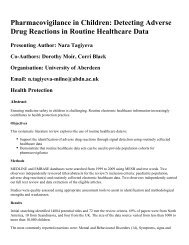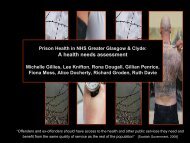Programme - Making Scotland a Healthier Place
Programme - Making Scotland a Healthier Place
Programme - Making Scotland a Healthier Place
Create successful ePaper yourself
Turn your PDF publications into a flip-book with our unique Google optimized e-Paper software.
Conference <strong>Programme</strong>Faculty of Public HealthCommittee of the Faculty of Public Health in <strong>Scotland</strong>AcknowledgementsThe conference organising group appreciate the contributions from the Faculty of Public Health, NHS Health<strong>Scotland</strong>, NHS Lothian, NHS Borders, NHS Fife, NHS Tayside, SCOTPHN, University of Edinburgh, Universityof St Andrews, University of Dundee and The Scottish Government.NHS Lothian provides a comprehensive range of primary,community-based and acute hospital services for the populationsof Edinburgh, Midlothian, East Lothian and West Lothian. Ithas the second largest residential population in <strong>Scotland</strong> –circa 800,000 people. It employs nearly 28,000 staff, includingapproximately 15,000 nurses and midwives and around 2,700medical staff. The region, which covers some 700 square miles,has long been recognised as having an outstanding naturalbeauty, complemented by a culture that is as cosmopolitan asit is inspiring. Lothian NHS Board is responsible for investingapproximately £1 billion a year in health care services. Its mainrole is to protect and improve the health of the people of Lothianand plan services for the local population.The Region of Fife is bounded in the north by the Firth of Tay, in theeast by the North Sea and in the South by the Firth of Forth. TheRegion spans an area of 130,700 hectares and has a populationof over 360,000. There is a highly developed agricultural sector inthe east and north-east Fife, and in the west there is an extensivecross section of highly skilled and scientifically orientated industry.The largest towns are Dunfermline , Kirkcaldy and Glenrothes. StAndrews is the seat of <strong>Scotland</strong>’s oldest university.The University of Edinburgh currently hosts around 30,000students who study across humanities and social science,science and engineering and medicine and veterinary medicine.The University attracts the greatest minds from across the globe,reflecting its position as one of the world¹s leading universities.Since it’s foundation more than 400 years ago, our people andtheir achievements have rewritten history time and again. They’veexplored space, revolutionised surgery, published era-definingbooks, paved the way for life-saving medical breakthroughs andintroduced to the world many inventions, discoveries and ideasfrom penicillin to Dolly the sheep. They have believed that anythingis possible. Our experts continue in that tradition, consistentlystriving to uncover the unknown, transforming science fiction intofact, and unveiling new possibilities for future generations.NHS Borders provides primary care, community services andacute hospital care (in the Borders General Hospital) to a widelydispersed population of 111,430 across an area of 1831 squaremiles. Two-thirds of the population live outside settlementsof 10,000 people, compared to 28% for <strong>Scotland</strong>. Hawick,Galashiels, Peebles, Kelso and Selkirk are the largest towns with apopulation of over five thousand. Sheep outnumber humans by 10to 1, so agriculture is still an important part of the local economy.The once dominant textile industry is now much smaller, howeverlocal business has diversified of late, although Scottish Borders isstill a low wage economy. The area has a rich historical traditionfrom the Borders Reiver days and contains a great variety ofbeautiful countryside, which stretches from the North Sea coastat Eyemouth to the Tweedsmuir Hills close, to the borders withLanarkshire and Dumfries & Galloway.Situated in the east of <strong>Scotland</strong>, Tayside has a population ofaround 394,000. The area is a mix of both urban and rural settingsand comprises Dundee city, Angus and Perth and Kinross. NHSTayside’s vision is to provide the highest quality care in the bestenvironment, to reduce health inequalities and to improve andprotect population-health. We strive to continually improve anddo this with the commitment of our 14,000 staff, our CommunityPlanning Partners, our service users and the public.Founded in the fifteenth century, St Andrews is <strong>Scotland</strong>’s firstuniversity and the third oldest in the English speaking world. Teachingbegan in the community of St Andrews in 1410 and the University wasformally constituted by the issue of Papal Bull in 1413. The Universityis now one of Europe’s most research intensive seats of learning – overa quarter of its turnover comes from research grants and contracts.It is one of the top rated universities in Europe for research, teachingquality and student satisfaction and is consistently ranked among theUK’s top five in leading independent league tables produced by TheTimes, The Guardian and the Sunday Times.The University of Dundee has a long history dating back to 1881when University College, Dundee was founded in associationwith the University of St Andrews, gaining independent universitystatus in 1967. The University has consistently provided pureand applied research and teaching at international levels ofexcellence, particularly in health and medicine, and is currentlyranked 140 among the world’s top 200 universities in the TimesHigher Education World University Rankings. The University isalso in the top ten UK Universities for teaching and learning in theTimes Higher Education Student Experience Survey of 2010. Overhalf of the University’s research is achieving ‘world leading’ or‘internationally excellent’ standards according to the most recentResearch Assessment Exercise. The Universities reputation isbuilt upon this strive for excellence and in 2010 became the firstapproved Cancer Research UK Centre in <strong>Scotland</strong>. With majortraining and research centres in clinical medicine, population andpublic health, nursing and dentistry, the teaching and research inhealth related areas is the major contributor to the Universitiescurrent standing. The university also has a reputation for itscollaborative approach to research with initiatives such as theSocial Dimensions of Health Institute (SDHI) in St Andrews, whichprovides a vehicle for innovative and cross disciplinary research.The Scottish Public Health Network (ScotPHN) is hosted by NHSHealth <strong>Scotland</strong> and is accountable to the Scottish Directors ofPublic Health collectively. It was created in 2006 as a collaborativenetwork which would add value to the work of Public HealthDirectorates and agencies across <strong>Scotland</strong>.Its formal remit is to:• undertake prioritised national pieces of work where there is aclearly identified need;• facilitate information exchange between public healthpractitioners, link with other networks and share learning;• create effective communication amongst professionals and thepublic to allow efficient co-ordination of public health activityand• support and enhance the capabilities and functionality of theScottish Directors of Public Health Group.Most recently, the first element of ScotPHN’s remit, that ofundertaking nationally prioritised projects, has been extendedto ensure any issues identified as nationally important by NHSBoards, Scottish Government and the National Planning Forumare undertaken and that these national public health priorities areundertaken in a co-ordinated manner across <strong>Scotland</strong>.12NHS National Services <strong>Scotland</strong>Scottish Health Service CentreCrewe Road SouthEdinburgh EH4 2LFTel: 0131 275 7748Fax: 0131 623 2525Email: publichealth@shscevents.co.ukwww.fphscotconf.co.uk









